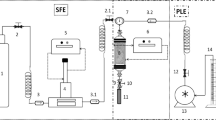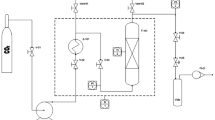Abstract
The main objective of this study was to recover hydroxytyrosol from olive mill waste (olive leaves and a semi-solid waste with a 65–75% of humidity called alperujo). The recovery process involved solid–liquid extractions using two hydrophilic deep eutectic solvents (DESs), CIS-DES (a 1:1 mixture of choline chloride and citric acid) and Etagline (a 1:2 mixture of choline chloride and ethylene glycol). The results achieved using this non-conventional process was compared with the results achieved using conventional solid–liquid extraction processes using ethanol, methanol, and water. The extraction ratio (R) achieved using Etagline DES was 11.4 times higher than the R achieved using methanol. The hydroxytyrosol extraction efficiencies were higher when using the selected DESs than using methanol, under the same working conditions. On the other hand, with the use of DES it is possible to obtain similar extraction efficiencies to those obtained with organic solvents, but using 75% less extraction phase, when DESs were used instead of methanol. The DES extraction processes gave high re-extraction capacities when supercritical CO2 was used as a stripping phase. The highest pure hydroxytyrosol extraction efficiency, 80%, was achieved using Etagline and supercritical CO2 re-extraction at a pressure and temperature close to the critical values. The results suggest that DES is an efficient, safe, and sustainable alternative to methanol for extracting bioactive compounds from olive mill waste and that DES extraction combined with supercritical CO2 extraction can be classed as a green process.
Graphic Abstract

Similar content being viewed by others
Abbreviations
- HT:
-
Hydroxytyrosol
- T:
-
Tyrosol
- OI:
-
Oleuropeine
- OMW:
-
Olive mill waste
- OL:
-
Olive leaves
- DESs:
-
Deep Eutectic Solvents
- CO2 :
-
Carbon dioxide
- EtOH:
-
Ethanol
- MetOH:
-
Methanol
- HPLC:
-
High performance liquid chromatography
- R:
-
Extraction ratio
- SCE:
-
Supercritical fluid extraction
- GAE:
-
Gallic acid equivalent
- w/w:
-
Refer to mass fraction
- v/v:
-
Referred to volume/volume percent
- DW:
-
Dry waste
- S/L:
-
Solid/liquid extraction process
References
El-Abbassi, A., Hafidi, A., García-Payo, M.C.: Integrated direct contact membrane distillation for olive mill wastewater treatment. Desalination 323, 31–38 (2013)
Cassano, A., Conidi, C., Giorno, L., Drioli, E.: Fractionation of olive mill wastewaters by membrane separation techniques. J. Hazard. Mater. 185, 248–249 (2013)
Chowdhury, A.K.M.M.B., Akratos, C.S., Vayenas, V. Pavlou, S.: Olive mill waste composting: a review. Int. Biodeterior. Biodegr. 85, 108–119 (2013).
Rubio-Senent, F., Rodríguez-Gutiérrez, G., Lama-Muñoz, A., Fernández-Bolaños, J.: Chemical characterization and properties of a polymeric phenolic fraction obtained from olive oil waste. Food Res. Int. 54, 2122–2129 (2013)
Robles-Almazan, M., Pulido-Moran, M., Moreno-Fernández, J., Ramirez-Tortosa, C., Rodriguez-Garcia, C., Quiles, J., Ramirez-Tortosa, M.C.: Hydroxytyrosol: Bioavailability, toxicity, and clinical applications. Food Res. Int. 105, 654–667 (2018)
Sun, Y., Zhou, D., Shahidi, F.: Antioxidant properties of tyrosol and hydroxytyrosol saturated fatty acid esters. Food Chem. 245, 1262–1268 (2018)
Bernini, R., Meredino, N., Romani, A., Velotti, F.: Naturally occurring hydroxytyrosol: synthesis and anticancer potential. Curr. Med. Chem. 20(5), 655–670 (2013)
Millares, P., Chisvert, A., Salvador, A.: Determination of hydroxytyrosol and tyrosol by liquid chromatography for the quality control of cosmetic products based on olive extracts. J. Pharmaceut. Biomed. 102, 157 (2015)
D’Antuono, I., Kontogianni, V., Kotsiou, K., Linsalata, V., Logriego, A., Tasioula- Margari, M., Cardinalli, A.: Polyphenolic characterization of olive mill wastewaters, coming from Italian and Greek olive cultivars, after membrane technology. Food Res. Int. 65, 301 (2014)
Sannino, F., De Martino, A., Capasso, R., El Hadrami, I.: Valorization of organic matter in olive mill wastewaters: Recovery of highly pure hydroxytyrosol. J J. Geochem. Explor 129, 34–39 (2013)
Fava, G., Di Mauro, M.D., Spampinato, M., Biondi, D., Gambera, G., Centonze, G., Maggiore, R., D’Antona, N.: Hydroxytyrosol recovery from olive mill wastewaters: Process optimization and development of a pilot plant. Clean-Soil Air Water 45(4), 1600042 (2017)
Allouche, N., Fki, I., Sayadi, S.: Toward a high yield recovery of antioxidants and purified hydroxytyrosol from olive mill wastewaters. J. Agric. Food Chem. 54, 267–273 (2004)
Galanakis, C.: Separation of macromolecules and micromolecules: from ultrafiltration to the border of nanofiltration. Trends Food Sci. Technol. 42, 44–63 (2015)
El-Abbassi, A., Hafidi, A., Khayet, M., García-Payo, M.C.: Integrated direct contact membrane distillation for olive mill wastewater treatment. Desalination 323, 31–38 (2013)
El-Abbassi, A., Khayet, M., Kiai, H., Hafidi, A., García-Payo, M.C.: Treatment of crude olive mill wastewaters by osmotic distillation and osmotic membrane distillation. Sep. Purif. Technol. 104, 327–332 (2013)
Garcia-Castello, E., Cassano, A., Criscuoli, A., Conidi, C., Drioli, E.: Recovery and concentration of polyphenols from olive mill wastewaters by integrated membrane system. Water Res. 44, 3883–3892 (2010)
Rubio-Senent, F., Rodríguez-Gutiérrez, G., Lama-Muñoz, A., Fernández-Bolaños, J.: Food Res. Int. 54, 114 (2013)
Ugurlu, M., Hazirbulan, S.: Removal of some organic compounds from pre-treated olive mill wastewater by sepiolite. Fresen. Environ. Bull. 16, 887 (2007)
García, A., Rodríguez-Juan, E., Rodríguez-Gutiérrez, G., Rios, J., Fernández-Bolaños, J.: Extraction of phenolic compounds from virgin olive oil by Deep Eutectic Solventes (DESs). Food Chem. 19, 554 (2016)
Dai, Y., van Spronsen, J., Witkamp, G.J., Verpoorte, R., Choi, Y.H.: Natural deep eutectic solvents as a new potential media for green technology. Anal. Chim. Acta 766, 61 (2013)
Sarrade, S., Guizard, C., Rios, G.M.: New application of supercritical fluids and supercritical fluids processes in separation. Sep. Purif. Technol. 32, 57–63 (2003)
Estay, H., Bocquet, S., Romero, J., Sanchez, J., Rios, G.M., Valenzuela, F.: Modeling and simulation of mass transfer in near-critical extraction using hollow fiber membrane contactor. Chem. Eng. Sci. 62, 5794 (2007)
Cabezas, R., Plaza, A., Merlet, G., Romero, J.: Effect of fluid dynamic conditions on the recovery of ABE fermentation products by membrane- based dense gas extraction. Chem. Eng. Process. 95, 80 (2015)
Valadez-Carmona, L., Ortiz-Moreno, A., Ceballos-Reyes, G.: Valorization of cacao pod husk through supercritical fluid extraction of phenolic compounds. J. Supercrit. Fluid. 131, 99 (2018)
Medeiros, L., Panizzon, G., Alves, B., Simionato, A., Cardozo-Filho, L., Andrade, G.,Gonçalves de Oliverira, A., Guedes, T., Palazzo, J.: Guarana (Paullinia cupana) seeds: selective supercritical extraction of phenolic compounds. Food Chem. 212, 703 (2016).
Baldino, L., Della, G., Sesti, L., Reverchon, E., Adami, R.: Concentrated Oleuropein powder from olive leaves using alcoholic extraction and supercritical CO2 assisted extraction. J. Supercrit. Fluid. 133, 65 (2018)
Şahin, S., Bilgin, M., Dramur, M.U.: Investigation of Oleuropein content in olive leaf extract obtained by supercritical fluid extraction and soxhlet methods. Sep. Sci. Technol. 46, 1829 (2011)
Sannino, F., De Martino, A., Capasso, R., El Hadrasmi, I.: Valorization of organic matter in olive mill wastewaters: Recovery of highly pure hydroxytyrosol. J. Geochem. Explor. 129, 34–39 (2013)
Hamza, M., Sayadi, S.: Valorization of olive mill wastewater by enhancement of natural hydroxytyrosol recovery. Int. J. Food Sci. Tech. 50, 826–833 (2015)
Bazzarelli, F., Piacentini, E., Poerio, T., Mazzei, R., Cassano, A.: Advances in membrane operation for water purification and biophenols recovery/valorization from OMWWs. J. Membrane Sci. 497, 402–409 (2016)
Fernández, M.A., Espino, M., Gomez, F., Silva, M.F.: Novel approaches mediated by tailor-made green solvents for the extraction of phenolic compounds from agro-food industrial by-products. Food Chem. 239, 671–678 (2018)
Chanioti, S., Tzia, C.: Extraction of phenolic compounds from olive pomace by using natural deep eutectic solvents and innovative extraction techniques. Innov. Food Sci. Emerg. 48, 228–239 (2018)
Perry, R.: Manual del Ingeniero Químico. Sexta Edición, Editorial McGraw- Hill. Tomo, vol. 3, pp. 10–293 (1992).
Fernández-Mar, M.I., Mateos, R., García-Parrilla, M.C., Puertas, B., Cantos-Villar, E.: Bioactive compounds in wine: resveratrol, hydroxytyrosol and melatonin: A review. Food Chem. 130, 797–813 (2013)
Acknowledgements
This study was performed as part of the research projects FONDECYT de Iniciación 11150255 and Project POSTDOC_DICYT, Código 0217111RF, Vicerrectoría de Investigación, Desarrollo e Innovación, Universidad de Santiago de Chile, Usach.
Author information
Authors and Affiliations
Corresponding author
Additional information
Publisher's Note
Springer Nature remains neutral with regard to jurisdictional claims in published maps and institutional affiliations.
Rights and permissions
About this article
Cite this article
Plaza, A., Tapia, X., Yañez, C. et al. Obtaining Hydroxytyrosol from Olive Mill Waste Using Deep Eutectic Solvents and Then Supercritical CO2. Waste Biomass Valor 11, 6273–6284 (2020). https://doi.org/10.1007/s12649-019-00836-1
Received:
Accepted:
Published:
Issue Date:
DOI: https://doi.org/10.1007/s12649-019-00836-1










